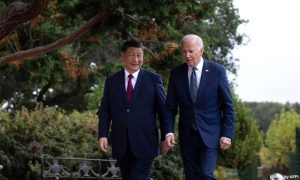ISLAMABAD: The Turkmenistan-Afghanistan-Pakistan and India (TAPI), also known as peace pipeline, is a 1,800-kilometre (1,120-mile) natural gas pipeline with a capacity to transport approximately 14 billion cubic meters of natural gas from Turkmenistan to Afghanistan, Pakistan, and India, originally scheduled to be completed in 2023.
According to the agreement, Pakistan and India were each scheduled to acquire 42% of the entire volume of produced gas, and Afghanistan 16% of the gas, equivalent to 5.11 billion cubic meters, in addition to collecting $400 million per year as a transit fee for the pipeline.
The 56-inch TAPI gas pipeline with a pressure of approximately 10,000 kilopascals (kPa) will transport gas from Turkmenistan’s Galkynysh gas field, also known as South Yolotan Osman, which has 16 trillion cubic feet of gas reserves, to Afghanistan over a distance of 214 kilometers. The Afghanistan segment is being built along the highway and will run for 774 kilometers through Kandhar and Herat in Afghanistan.
Later, it will travel 826 kilometers through Pakistan, passing through the cities of Quetta and Multan before ending in Fazilka at the Indo-Pakistan border in the Punjab region of India. The pipeline will initially transport 27 billion cubic meters of natural gas per year, which will be raised to 33 billion cubic meters after one year of operation. The following timeline was assigned to the project, which was conceived in 1999:
- 1999: Turkmenistan, Afghanistan, and Pakistan sign a memorandum of understanding (MoU) to study the feasibility of a natural gas pipeline.
- 2003: India joins, three countries sign a trilateral agreement to build the pipeline.
- 2006: The four countries sign a framework to finalize the terms of the project.
- 2008: The signatories created the TAPI Pipeline Company Limited (TAPIPCL).
- 2010: The four countries sign a gas sale and purchase agreement (GSPA).
- 2011: Construction on the Turkmenistan section of the pipeline begins.
- 2012: Construction on the Afghanistan section of the pipeline begins.
- 2013: Construction on the Pakistan section of the pipeline begins.
- 2016: The Turkmenistan section of the pipeline is completed.
- 2017: The Afghanistan section of the pipeline is completed.
- 2018: The Pakistan section of the pipeline is completed.
- 2023: The TAPI pipeline is scheduled to start commercial operations.
The project was initially on track, but due to the security situation in Afghanistan and tensions between Pakistan and India, numerous deadlines were missed. However, the idea of successfully commissioning TAPI has now become a reality following the peace in Afghanistan. According to credible sources, there is an unusual quiet in Afghanistan, with killing having ceased in late 2021 across the vast majority of Afghan land.
Under Taliban administration the country is far more tranquil than it was a year ago. The Taliban have removed hundreds of checkpoints on highways and roads, enforced policing as part of ambitious plans for a huge security structure which made possible for the stakeholder to move ahead with full speed simultaneously on all aspects of the project.
With Turkmengaz leading,Turkmengaz (majority stakeholder with 85% interest), Afghan Gas Enterprise (5%), Inter State Gas Systems (5%), and GAIL (5%) formed a special-purpose consortium known as the TAPI Pipeline Company (TPCL) in November 2014 to execute the $10 billion project.
A stone-laying ceremony was performed in Mary, Turkmenistan, near the Galkynysh gas field, to commemorate the commencement of construction of the Turkmenistan-Afghanistan segment of the TAPI gas pipeline in December 2015 (originally planned in 2011).
The four countries inked an investment agreement for the development of the TAPI project in February 2016. The ceremony to celebrate the start of work of the pipeline’s Afghanistan-Pakistan segment was held in February 2018 (it was originally scheduled in 2017).
The TAPI pipeline is being constructed in two phases. A free flow pipeline with a capacity of delivering approximately 11bcm/year will be developed in the first phase, with two compressor stations in Turkmenistan. The second phase will add six compressor stations in the Afghanistan and Pakistan regions to increase the delivery capacity to approximately 33bcm/year. Overall, the pipeline will supply 90 million metric standard cubic metres (Mmscm) of natural gas a day.
The Asian Development Bank (ADB) is funding the TAPI project and serving as the project’s transaction adviser.
In December 2016, Turkmenistan received a $700 million loan from the Islamic Development Bank to fund the project. The remaining three countries contributed $200 million to the TAPI initiative. Penspen, a UK-based firm, was hired to do technical feasibility studies for the TAPI project. Penspen subcontracted Royal Haskoning DHV to conduct several studies relevant to the initiative’s environmental and social protection components.
ILF Consulting Engineers was granted a contract to conduct the pipeline’s front-end engineering and design (FEED) studies. Global Pipe Company, a Saudi-German joint venture, was awarded a $40 million contract for the construction of the TAPI gas pipeline.
The contract also includes the supply of technical supervision services for the pipeline network’s Afghanistan-Pakistan segment. The TAPI pipeline is currently under construction. The pipeline’s Turkmenistan segment is nearly 80% complete, and the Afghanistan part is around 60% complete. The pipeline’s Pakistan section is still in the development stages.
However, India as yet has doubts and aspersion to fully participate in the project. One of India’s main concerns was that once the project is operating, many Indian companies will rely on it. Pakistan can use this by cutting off supply during times of conflict, resulting in massive losses. Furthermore, India, which is a stakeholder, has yet to officially recognize the Taliban rule in Afghanistan.
However, Pakistan, which is short on energy, has expressed a willingness to continue with the TAPI gas pipeline project even without India. If India decides to abandon the project, Pakistan is said to be willing to buy India’s projected portion of the gas.
The interim Afghan government is prepared to raise a special force to protect the pipeline, which would profit from transit fees equal to about 80 to 85 percent of Afghanistan’s yearly budget, providing a significant incentive for the Afghan side to assure pipeline security. Pakistan is also planning to incorporate Saudi capital or a multilateral financial mechanism into the initiative to reshape the region’s energy and security situation. If the Saudis agree, companies such as the SDF, PIF, and Exim Bank might be brought on board, potentially resulting in the establishment of a cascade of industries such as transferring natural gas from Turkmenistan to Gwadar, converting it to LNG and exporting it to energy-starved Europe and the entire west.
Unlike Turkmenistan, which is expected to earn billions of dollars in export earnings from natural gas sales, Afghanistan will benefit from job creation, economic growth potential, and the regular payment of transit fees and gas to its people. Pakistan will benefit from enhanced natural gas supply, a considerable economic boost, and an uninterrupted supply of price competitive natural gas at its doorstep, reducing the dependency of millions of residential users and thousands of industrial units on expensive and unpredictable imported oil and gas. India would benefit from increased natural gas supply, which would help it meet its growing energy demands.
Because TAPI gas is expected to be less expensive than alternatives such as liquefied natural gas (LNG), which is transported by tanker and then regasified at its destination. LNG is more expensive than pipeline gas due to the additional expenditures of liquefaction and regasification. According to a study conducted by the Asian Development Bank, TAPI gas may be up to 20% cheaper than LNG imports. Because TAPI gas will be transported straight from Turkmenistan to India via Afghanistan and Pakistan, there will be no need for liquefaction or regasification. The lower cost of TAPI gas may help recipient countries reduce their reliance on imported LNG and their sensitivity to price shocks.
This project saw rapid progress despite many hiccups due to the Shahbaz Speed, and if this speed maintains its momentum in the coming days, days will not be far away when our households will enjoy uninterrupted supply of gas and our industries will not only enjoy cost-effective raw materials for many of their processes, but would also meet their energy needs, making their products and services cost-effective in comparison to their competitors and would capture domestic and international market share. Furthermore, the country would save precious foreign currency that would otherwise be used to import gas and oil from expensive and volatile international markets.























